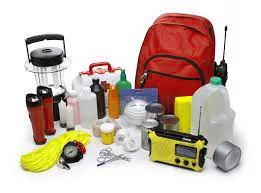Understanding the Necessity of Emergency Preparedness
Picture yourself getting up to a loud snowstorm, with no electricity and roads blocked. Or think of a wildfire coming closer and you have to leave quickly with very little time left. These situations, though scary, remind us strongly about life’s unpredictability. Disasters, both from nature and made by people can happen any time. They even make strong communities shocked.
Here’s why preparedness is paramount:
• Improves your chances of survival: Having important things ready when there’s an emergency can give you extra time until someone helps or services get fixed.
• Provides peace of mind: Knowing you’re ready can stop worry and make you strong to act coolly when something bad happens.
• Protects your loved ones: Make sure your family’s needs are met, then you can concentrate on dealing with the problem together.
• Reduces reliance on external aid: A good kit reduces reliance on busy emergency services, letting them help those who need it most.

Recognizing the Scope of Potential Emergencies
Before putting together your kit, it’s helpful to understand the various dangers where you live. Some places have extra risks like hurricanes or earthquakes, but others could get floods, be hit by snowstorms or lose power. Learn about the hazards in your location to make a kit.
Here are some common emergencies to consider:
• Natural disasters: Big storms or bad events like hurricanes, tornadoes, floods, earthquakes and wildfires can cause a lot of harm.
• Technological failures: Lack of power, dirty water, broken communication lines.
• Medical emergencies: Becoming ill quickly, getting injured and not being able to visit a doctor.
• Civil unrest: Protests, riots, evacuations.

Understanding Your Risk Zone
Look for old accidents in your area and check how unsafe it is now. FEMA’s flood maps, weather service warnings and plans from local emergency managers can give helpful information.
Creating Your Kit Based on What You Need:
Think about things like how many family members there are, what kind of food you can or can’t eat, health issues and those who need special help like kids or elderly folks.
Assessing Your Preparedness Needs: Building a Kit Tailored to You
Before you start putting together your survival kit, it’s important to first look at what you really need. This forward-thinking method stops you from creating a basic collection that may fail to fit your special weaknesses or the place you live in. Let’s delve into the key factors to consider:
Figuring Out How Long Disaster Readiness Lasts
Consider more than just the first few hours after a disaster. Can your kit keep you and your family going for 48, 72 or even 96 hours? Some areas might need to be self-sufficient for a longer time, especially if escape paths are blocked or getting better takes time. Things like how bad emergencies can be where you live and how easy it is to get help should help you figure out what’s right.
Here are some questions to ponder:
• How long can you truly manage without power, water and communication?
• Can roads get blocked or travel plans be messed up?
• Do you have family members in your home who might need extra supplies or help?
If you honestly answer these questions, you can set a true time period for your kit and arrange the items in order of importance.
Considering special needs that depend on location and environment.
Where you live is very important in deciding what’s in your kit. If you live in a place near the sea where big storms called hurricanes can happen, it needs different preparations than if you live in a dry area like the desert that can catch fire easily. Consider these factors:
• Climate and Weather: Do extreme seasons happen regularly? Does your area deal with certain weather dangers like big snowstorms or very hot temperatures?
• Terrain and Topography: Mountains, valleys, or flat plains? Where you are can affect how to get out and what kind of shelter you might need.
• Local Infrastructure: Dependable services or potential long-lasting blackouts? Do we use hospitals or do it ourselves in emergencies?
Knowing the special problems of where you are lets you add certain things to your kit so they can handle them well.
Shelter and Warmth Essentials: Building Your Fortress of Resilience
When bad things happen, having a secure and cozy place to stay becomes more than just extra nice – it could be the help we need to survive. This section guides you through establishing the cornerstone of your survival kit: Shelter and Warmth Essentials.
Blankets for Emergencies and Bags to sleep in:
These lightweight wonders are very important for keeping our bodies warm and stopping bad weather.
• Emergency Blankets: Small and thoughtful, these wonderful space things send back 90% of your body heat to you. This helps stop low body temperature in very important situations. They are strong, can be used again and they help keep things warm on the ground. You can also use them in emergencies to signal for help or protect a wound.
• Sleeping Bags: Pick a bag that can handle the right amount of heat or cold for where you live. Synthetic bags have strong resistance against moisture, while down bags are lighter and offer better heat. Look at bags like mom made for the best protection or square bags if you want more space to move.
Portable Shelter Options:
Finding strong cover is very key when there’s bad weather or risky spots.
• Tents: Pick tents that are good against rain, easy to set up and big enough for your things. Consider getting a dome tent if there’s wind, or a big family one when you want to camp with more than one person. Bivy sacks are light choices for one person in emergencies. They serve as shelters.
• Tarps: You can easily use tarps and they can be changed. They are good at keeping you safe from rain and sun. Use them to make easy houses, cover the floor or stop winds. Pick strong tarps with grommets for safe connections that last a long time.
Conclusion: Building Your Fortress of Resilience
Making a kit for emergencies is not only buying things; it’s also about thinking ahead and feeling strong enough to handle surprises. Take time to find out what you need, change your kit based on where you live and possible danger. Buy the best tools so they can keep you and your family safe from danger.
Imagine your kit as a stable fortress of strength, something that physically shows you are prepared. In it, you can handle hard times and maintain comfort while also going through unknown things with a sense of control. Remember, a good kit can be very helpful in tough times after an emergency. It gives you what you need to stay alive and makes you feel calm when everything around is chaotic.
Frequently Asked Questions (FAQs):
How regularly must I update my emergency survival kit?
Regularly assessment and update your package to make certain its contents are nonetheless in desirable circumstance and relevant for your desires. Replace expired items, regulate quantities based on adjustments for your circle of relatives size or nutritional desires, and keep in mind incorporating new items primarily based on evolving dangers to your location.
What need to I do with my package whilst it is now not in use?
Store your package in a groovy, dry, and effortlessly available area, ideally faraway from capacity risks like flooding or fire. Clearly label the box and make certain all of us in your household is aware of wherein it’s miles and a way to get entry to it.
What extra assets can assist me with emergency preparedness?
Numerous valuable sources are available to manual you on your preparedness adventure. Here are a few:
• Ready.Gov: The reliable internet site of the U.S. Department of Homeland Security, providing comprehensive records and resources on emergency preparedness.
• American Red Cross: Provides useful suggestions and guidance on building emergency kits, preparing for unique hazards, and staying knowledgeable.
• FEMA: The Federal Emergency Management Agency website gives catastrophe preparedness sources, maps, and data on specific danger risks.
How do I shop my emergency survival kit?
Store your kit in a cool, dry location that is effortlessly handy in case of an emergency. A water-resistant container is recommended to protect your substances from moisture and damage. Consider having more than one kits, one for your house and some other for your automobile.
What particular items need to I encompass if I live in a selected kind of environment?
If you live in a place prone to positive types of emergencies, tailor your package as a result. For example, if you stay in a chilly weather, include greater layers of garb and insulation. If you stay in a place liable to hurricanes, add water resistant equipment and hurricane components.
Where can I purchase an emergency survival kit?
You can buy pre-made emergency survival kits online or at many retail shops. However, it’s miles frequently extra cost-effective and customizable to collect your very own package.
